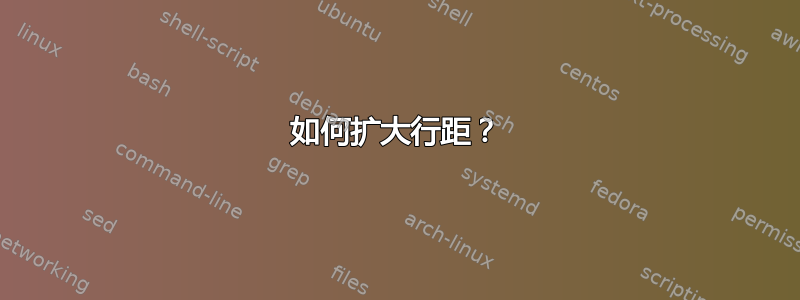
我想制作像照片 1 中那样的乳胶文件{我想在行之间留出空格。
\documentclass[12pt]{amsart}
\begin{document}
{\center \section {\bfseries Matricat} }
\subsection{\bfseries Shembulli i pare, Matrica}
\begin{equation*}
\left(\begin{array}{c}a_{11}\quad a_{12}\quad \cdots\quad a_{1n} \\ a_{21}\quad a_{22} \quad \cdots\quad a_{2n} \\ \vdots\qquad \vdots \qquad \ddots \quad \vdots\\ a_{n1} \quad a_{n2} \quad \cdots \quad a_{nn} \end{array}\right)
\end{equation*}
Kjo matrice eshte prodhua duke perdore komanden pmatrix makro~\cite{referenca1} ne blloqe begin[matrix]. Disa matrica jane te mundshme duke perdore komandat per mjediset apo environment-et: \\ \textbf{matrix}~\cite{referenca2}, \textbf{pmatrix}~\cite{referenca3}, \textbf{bmatrix}~\cite{referenca4}, \textbf{Bmatrix}~\cite{referenca5}, \textbf{vmatrix}~\cite{referenca6}, \textbf{Vmatrix}~\cite{referenca7}, te cilat prodhojne matricat si ne vijim ~\cite{referenca8}:
\begin{equation*}
\begin{matrix} r & s & t \\u & v & w \\x & y & z \end{matrix}\qquad \begin{pmatrix}r\quad s\quad t\\ u\quad v\quad w\\ x\quad y\quad z\end{pmatrix} \qquad \begin{bmatrix}r & s & t\\ u &v&w \\ x & y & z \end{bmatrix}
\end{equation*}
\end{document}
答案1
你可以使用tabular*以下方法:
\documentclass[12pt]{amsart}
\usepackage[T1]{fontenc}
\usepackage[utf8]{inputenc} % for ç
\usepackage[albanian]{babel}
\usepackage{booktabs} % for tables
\usepackage{xpatch} % for patching macros
% boldface section titles, not small caps
\xpatchcmd{\section}{\scshape}{\bfseries}{}{}
\begin{document}
\section{Matricat}
\subsection{Shembulli i pare, Matrica}
\begin{equation*}
\left(
\begin{array}{cccc}
a_{11} & a_{12} & \cdots & a_{1n} \\
a_{21} & a_{22} & \cdots & a_{2n} \\
\vdots & \vdots & \ddots & \vdots \\
a_{n1} & a_{n2} & \cdots & a_{nn}
\end{array}
\right)
\end{equation*}
Kjo matrice eshte prodhua duke perdore komanden pmatrix
makro~\cite{referenca1} ne blloqe \verb|\begin{matrix}|. Disa matrica
jane te mundshme duke perdore komandat per mjediset apo
environment-et: \texttt{matrix}~\cite{referenca2},
\texttt{pmatrix}~\cite{referenca3}, \texttt{bmatrix}~\cite{referenca4},
\texttt{Bmatrix}~\cite{referenca5}, \texttt{vmatrix}~\cite{referenca6},
\texttt{Vmatrix}~\cite{referenca7}, te cilat prodhojne matricat si ne
vijim ~\cite{referenca8}:
\begin{equation*}
\begin{tabular*}{\displaywidth}{@{\qquad\extracolsep{\fill}}ccc@{\qquad}}
$\begin{matrix} r & s & t \\u & v & w \\x & y & z \end{matrix}$
&
$\begin{pmatrix}r & s & t\\ u & v & w\\ x & y & z\end{pmatrix}$
&
$\begin{bmatrix}r & s & t\\ u &v&w \\ x & y & z \end{bmatrix}$
\\ \addlinespace
$\begin{Bmatrix} r & s & t \\u & v & w \\x & y & z \end{Bmatrix}$
&
$\begin{vmatrix}r & s & t\\ u & v & w\\ x & y & z\end{vmatrix}$
&
$\begin{Vmatrix}r & s & t\\ u &v&w \\ x & y & z \end{Vmatrix}$
\end{tabular*}
\end{equation*}
\end{document}
如果你把上面\addlinespace的改成\addlinespace[4ex]
一些注释
避免使用诸如{\center\section{\bfseries Matricat}}: 如果您无法更改默认设置,请保留它并在此处询问。同样,避免使用诸如 之类的格式指令\subsection{\bfseries Shembulli i pare, Matrica},因为这可能会产生意想不到的后果。
答案的大部分是使用tabular*,但我也做了其他调整。
答案2
您只需使用\\行之间的可选参数:
\documentclass[12pt]{amsart}
\begin{document}
{\center \section {\bfseries Matricat} }
\subsection{\bfseries Shembulli i pare, Matrica}
\begin{equation*}
\left(\begin{array}{c}a_{11}\quad a_{12}\quad ⋯ \quad a_{1n} \\ a_{21}\quad a_{22} \quad ⋯ \quad a_{2n} \\ ⋮ \qquad ⋮ \qquad ⋱ \quad ⋮ \\ a_{n1} \quad a_{n2} \quad ⋯ \quad a_{nn} \end{array}\right)
\end{equation*}
Kjo matrice eshte prodhua duke perdore komanden pmatrix makro~\cite{referenca1} ne blloqe begin[matrix]. Disa matrica jane te mundshme duke perdore komandat per mjediset apo environment-et: \\ \textbf{matrix}~\cite{referenca2}, \textbf{pmatrix}~\cite{referenca3}, \textbf{bmatrix}~\cite{referenca4}, \textbf{Bmatrix}~\cite{referenca5}, \textbf{vmatrix}~\cite{referenca6}, \textbf{Vmatrix}~\cite{referenca7}, te cilat prodhojne matricat si ne vijim ~\cite{referenca8}:%
\begin{gather*}
\begin{matrix} r & s & t \\u & v & w \\x & y & z \end{matrix}\qquad \begin{pmatrix}r\quad s\quad t\\ u\quad v\quad w\\ x\quad y\quad z\end{pmatrix} \qquad \begin{bmatrix}r & s & t\\ u &v&w \\ x & y & z \end{bmatrix}\\[6ex]
\begin{Bmatrix}r & s & t \\u & v & w \\x & y & z \end{Bmatrix}\qquad \begin{vmatrix}r\quad s\quad t\\ u\quad v\quad w\\ x\quad y\quad z\end{vmatrix} \qquad \begin{Vmatrix}r & s & t\\ u &v&w \\ x & y & z \end{Vmatrix} \end{gather*}
\end{document}
答案3
您不能在equation*环境中引入换行符。因此,将三个矩阵的集合设置在 内array,然后您可以使用\\[<len>]在矩阵的任何后续行之间引入合适的空格:
\documentclass{amsart}
\usepackage[nopar]{lipsum}
\begin{document}
\section{A section}
\subsection{A subsection}
\begin{equation*}
\left(\begin{array}{ @{} *{4}{c} @{} }
a_{11} & a_{12} & \cdots & a_{1n} \\
a_{21} & a_{22} & \cdots & a_{2n} \\
\vdots & \vdots & \ddots & \vdots \\
a_{n1} & a_{n2} & \cdots & a_{nn}
\end{array}\right)
\end{equation*}
\lipsum[1]:
\begin{equation*}
\begin{array}{c}
\begin{matrix}
r & s & t \\
u & v & w \\
x & y & z
\end{matrix} \qquad
\begin{pmatrix}
r & s & t \\
u & v & w \\
x & y & z
\end{pmatrix} \qquad
\begin{bmatrix}
r & s & t \\
u & v & w \\
x & y & z
\end{bmatrix} \\[5\normalbaselineskip]
\begin{matrix}
r & s & t \\
u & v & w \\
x & y & z
\end{matrix} \qquad
\begin{pmatrix}
r & s & t \\
u & v & w \\
x & y & z
\end{pmatrix} \qquad
\begin{bmatrix}
r & s & t \\
u & v & w \\
x & y & z
\end{bmatrix}
\end{array}
\end{equation*}
\end{document}







